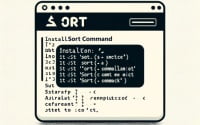‘whoami’ Command Guide | Displaying User Info in Linux

Have you ever found yourself lost in the vast world of Linux, unsure of your identity within the system? You’re not alone. Many users find themselves in this predicament, but the ‘whoami’ command can help you find your bearings. Think of the ‘whoami’ command as your personal Linux mirror – it reflects your identity within the system, revealing the username associated with the current user. It’s a simple, yet powerful tool that can be incredibly useful in various scenarios.
In this guide, we’ll walk you through the ‘whoami’ command in Linux, from its basic use to more advanced applications. We’ll cover everything from the basics of displaying the current user, to using ‘whoami’ in scripts, and even alternative approaches for the same task.
So, let’s dive in and start mastering the ‘whoami’ command in Linux!
TL;DR: What Does the ‘Whoami’ Command Do in Linux?
The
'whoami'command in Linux is a built-in utility that displays the username of the current user. It is used with the syntax,whoami [option]. It’s a quick and easy way to confirm your identity within the system.
Here’s a simple example:
$ whoami
# Output:
# username
In this example, we’ve used the ‘whoami’ command in the terminal. The command returns ‘username’, which is the username of the current user. This can be particularly useful when you’re logged into a Linux system and need to quickly confirm which user you’re operating as.
But there’s much more to the ‘whoami’ command than meets the eye. Continue reading for a deeper dive into its functionality, including more complex uses and alternative approaches.
Table of Contents
The Basic Use of ‘Whoami’
In its simplest form, the ‘whoami’ command is used to display the username of the current user. It’s a straightforward command that even beginners can use with ease. If you’re logged into a Linux system and you’re not sure which user you’re operating as, the ‘whoami’ command can quickly provide the answer.
Let’s look at a basic example of how to use the ‘whoami’ command:
$ whoami
# Output:
# anton
In this example, the command returns ‘anton’, which is the username of the current user. This means that the current user logged into the Linux system is ‘anton’.
The ‘whoami’ command is a quick and easy way to confirm your identity within the system. It’s especially useful if you’re logged into multiple Linux systems and you need to keep track of your user identity on each one.
Advanced Use Cases of ‘Whoami’
As you become more comfortable with the ‘whoami’ command, you’ll discover that it can be used in more complex scenarios than just displaying the current user. It can be used in scripts or combined with other commands to produce more detailed information about the system.
Before we dive into the advanced usage of ‘whoami’, let’s familiarize ourselves with some of the command-line arguments or flags that can modify the behavior of the ‘whoami’ command.
| Argument | Description | Example |
|---|---|---|
-a | Print all current information in report form. | whoami -a |
-m | Only hostname and user associated with stdin. | whoami -m |
-p | Show process id and process group id. | whoami -p |
-q | All names (repeated once if multiple users). | whoami -q |
-r | Print the real ID instead of the effective ID. | whoami -r |
-s | List only the name, line and time fields. | whoami -s |
-T | Print with SELinux context. | whoami -T |
-u | Show only effective user ID. | whoami -u |
Now that we have a basic understanding of ‘whoami’ command line arguments, let’s dive deeper into the advanced use of ‘whoami’.
Using ‘Whoami’ in Scripts
The ‘whoami’ command can be incredibly useful in shell scripts. For instance, you might have a script that should only be run by a specific user. You can use ‘whoami’ to check the current user and exit the script if the user is not the one you expected.
Here’s an example of how you might do this:
if [ $(whoami) != 'root' ]; then
echo 'This script must be run as root!'
exit 1
fi
# Output:
# This script must be run as root!
Combining ‘Whoami’ with Other Commands
The ‘whoami’ command can also be combined with other commands to produce more detailed information. For example, you can use ‘whoami’ with the ‘id’ command to display the user ID along with the username.
Here’s an example:
echo "You are $(whoami) and your user ID is $(id -u)"
# Output:
# You are anton and your user ID is 1000
In this example, the command returns both the username and the user ID of the current user. This can be useful in scenarios where you need to confirm both the identity and the permissions of the current user.
The ‘whoami’ command is a powerful tool in the Linux command line. With a little creativity, it can be used in a variety of advanced scenarios to help you manage your Linux system more effectively.
Exploring Alternatives to ‘Whoami’
While ‘whoami’ is a powerful command, there are other commands in Linux that can accomplish the same task. In this section, we’ll explore two such commands: ‘id -un’ and ‘logname’. We’ll explain how to use these commands, their benefits and drawbacks, and when you might choose to use them over ‘whoami’.
Using ‘id -un’ to Display the Current User
The ‘id -un’ command is a great alternative to ‘whoami’. Like ‘whoami’, it displays the username of the current user. However, ‘id -un’ is part of the ‘id’ command, which can provide much more detailed information about a user.
Here’s an example of how to use ‘id -un’:
$ id -un
# Output:
# anton
In this example, the command returns ‘anton’, just like the ‘whoami’ command. However, the ‘id’ command can also display the user ID, group ID, and groups the user is a part of. This makes it a more versatile tool if you need more detailed information.
Using ‘logname’ to Display the Current User
The ‘logname’ command is another alternative to ‘whoami’. It displays the name of the user who is currently logged in. While this is often the same as the current user, it can be different if the user has switched accounts using the ‘su’ command.
Here’s an example of how to use ‘logname’:
$ logname
# Output:
# anton
In this example, the command returns ‘anton’, indicating that ‘anton’ was the original user who logged in. This can be useful in scenarios where you need to confirm the original login, rather than the current user.
Making the Right Choice
When deciding whether to use ‘whoami’, ‘id -un’, or ‘logname’, consider what information you need. If you only need the current user, ‘whoami’ is a simple and straightforward choice. If you need more detailed user information, ‘id -un’ might be a better option. And if you need to confirm the original login, ‘logname’ can provide the answer.
While ‘whoami’ is a straightforward command, you may occasionally run into issues or unexpected results. In this section, we’ll discuss some common errors and obstacles you might encounter when using ‘whoami’, and how to solve them. We’ll also share some tips for best practices and optimization.
Understanding Permission Issues
One common error you might encounter when using ‘whoami’ is a permission issue. For instance, you might get a ‘Permission denied’ error if you try to run a script as a non-root user that requires root permissions.
Here’s an example of what this might look like:
$ sudo -u nobody whoami
# Output:
# nobody
In this example, we’re trying to run the ‘whoami’ command as the ‘nobody’ user using ‘sudo’. The command returns ‘nobody’, indicating that we’ve successfully switched to the ‘nobody’ user.
Dealing with Non-Existent Users
Another potential obstacle is trying to switch to a user that doesn’t exist. If you try to do this, you’ll get a ‘no such user’ error.
Here’s an example of what this might look like:
$ su non_existent_user -c whoami
# Output:
# su: user non_existent_user does not exist
In this example, we’re trying to switch to a user called ‘non_existent_user’ using ‘su’. The command returns an error message, indicating that the user doesn’t exist.
Best Practices and Optimization
When using ‘whoami’, it’s a good practice to always check your command for typos or syntax errors before running it. This can help you avoid common errors and save time.
Additionally, if you’re writing a script that uses ‘whoami’, consider adding error handling to your script. This can help you catch and handle errors gracefully, making your script more robust and reliable.
Finally, remember that ‘whoami’ is just one of many tools available in Linux for managing users. It’s a powerful command, but don’t be afraid to explore other commands and tools as well. The more tools you’re familiar with, the more effective you’ll be at managing your Linux system.
The Linux User System and the Importance of ‘Whoami’
In order to fully appreciate the utility of the ‘whoami’ command, it’s important to understand the Linux user system. Linux is a multi-user operating system, meaning it allows multiple users to access and use the system simultaneously. Each user has a unique username and a unique user ID.
When you log into a Linux system, you’re typically logging in as a specific user. This user has certain permissions and capabilities, depending on its configuration. For instance, the root user (also known as the superuser) has unlimited permissions and can perform any operation on the system.
Knowing which user you’re currently operating as is crucial. It can affect what files you can access, what commands you can run, and what changes you can make to the system. This is where the ‘whoami’ command comes in.
‘Whoami’ in the Broader Context of Linux Commands
In the grand scheme of Linux commands, ‘whoami’ is a part of a family of commands that provide information about the system and its users. Other commands in this family include ‘id’, ‘passwd’, ‘useradd’, and ‘userdel’.
‘Whoami’ is particularly related to the ‘id’ command. While ‘whoami’ simply displays the username of the current user, ‘id’ can provide more detailed information, including the user ID, group ID, and supplementary groups of a user.
Here’s an example of how to use ‘id’ to display this information:
$ id
# Output:
# uid=1000(anton) gid=1000(anton) groups=1000(anton),4(adm),24(cdrom),27(sudo),30(dip),46(plugdev),116(lpadmin),126(sambashare)
In this example, the command returns a wealth of information about the current user ‘anton’. This includes the user ID (uid), group ID (gid), and a list of groups that the user is a part of.
Understanding how ‘whoami’ fits into the broader context of Linux commands can help you use it more effectively. It’s a simple command, but it’s part of a powerful suite of tools for managing users on a Linux system.
Expanding Horizons: ‘Whoami’ in Larger Contexts
The ‘whoami’ command, while simple in its function, can play a crucial role in larger scripts or projects. Its ability to determine the current user can be leveraged in various ways to enhance the functionality and security of your scripts.
For instance, you might have a script that should only be run by a specific user, such as the root user. You can use ‘whoami’ at the beginning of your script to check if the current user is the root user. If it’s not, you can exit the script before it performs any actions.
Here’s an example of how you might do this:
if [ $(whoami) != 'root' ]; then
echo 'This script must be run as root!'
exit 1
fi
# Output:
# This script must be run as root!
In this example, the script checks if the current user is the root user. If it’s not, it prints a message and exits. This can be a useful way to prevent unauthorized users from running your script.
Semi-related Commands That Often Accompany ‘Whoami’
There are several commands that often accompany ‘whoami’ in typical use cases. These include commands like ‘su’, which allows you to switch to another user, and ‘sudo’, which allows you to run commands as another user.
For instance, you might use ‘su’ to switch to another user, then use ‘whoami’ to confirm that you’ve switched successfully. Here’s an example:
$ su - anton
Password:
$ whoami
# Output:
# anton
In this example, we’ve used ‘su’ to switch to the user ‘anton’, then used ‘whoami’ to confirm that we’re now operating as ‘anton’.
Further Resources for Mastering Linux Commands
While this guide provides a comprehensive overview of the ‘whoami’ command, there’s always more to learn. Here are a few resources that offer more in-depth information about ‘whoami’ and related Linux commands:
- The Linux Command Line – A Complete Introduction: This book provides a comprehensive introduction to the Linux command line, including detailed explanations of commands like ‘whoami’.
Whoami invocation: This page in the GNU Coreutils manual provides a detailed explanation of the ‘whoami’ command and its options.
Linux Whoami Command by Linuxize: This guide offers a detailed overview of the ‘whoami’ command, including examples of how to use it in various scenarios.
Wrapping Up: Use Cases of ‘Whoami’ in Linux
In this comprehensive guide, we’ve explored the ‘whoami’ command in Linux, a simple yet powerful tool that reveals your identity within the system. From basic usage to advanced applications, we’ve covered the various ways ‘whoami’ can be utilized to enhance your Linux experience.
We began with the basics, learning how to use ‘whoami’ to display the username of the current user. We then delved deeper into the command, exploring its use in scripts and in combination with other commands. We also looked at how ‘whoami’ can be used to enhance the functionality and security of your scripts.
Along the way, we tackled common issues you might encounter when using ‘whoami’, such as permission issues and non-existent users, providing you with solutions and workarounds for each issue.
We also explored alternative approaches to displaying the current user, comparing ‘whoami’ with other commands like ‘id -un’ and ‘logname’. Here’s a quick comparison of these commands:
| Command | Usage | Complexity |
|---|---|---|
| whoami | Displays the username of the current user | Simple |
| id -un | Displays the username of the current user and can provide more detailed user information | Moderate |
| logname | Displays the name of the user who is currently logged in | Simple |
Whether you’re a Linux newbie or an experienced user, we hope this guide has given you a deeper understanding of the ‘whoami’ command and its capabilities. With its simplicity and versatility, ‘whoami’ is a valuable tool in your Linux toolkit. Happy navigating!


